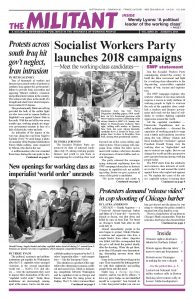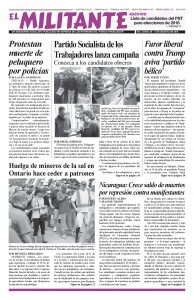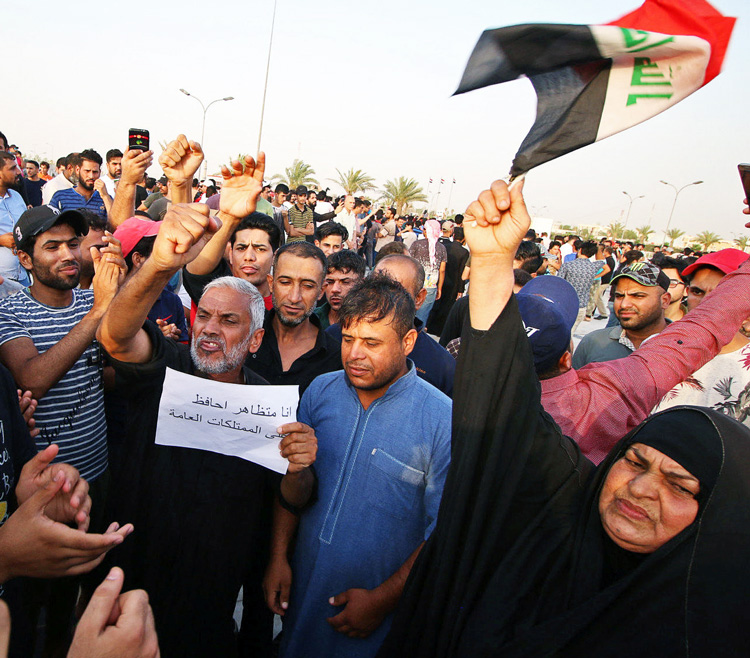Tens of thousands of workers and farmers have joined weeks of protests in southern Iraq against the government’s failure to provide basic necessities and opposing Tehran’s military, economic and political intervention in the country. The actions took place in the midst of a drought and a heat wave where temperatures reached 122 degrees.
This predominantly Shiite area of Iraq provided the bulk of the militia fighters who were used as cannon fodder in Baghdad’s war against Islamic State in the north. With the end of the war seven months ago, working people are angry over government inaction in face of a lack of electricity, water and jobs.
An indication of the impact of the war runs along the road from Najaf to Karbala. Every 50 yards hangs a photo of a member of the Popular Mobilization Forces Shiite militias, some organized by Tehran, who died in the war.
A militia member who was wounded three times during the war spoke to Rudaw news agency at the protest in Baghdad July 20. “It has been seven months since they cut my salary,” he said. “Is this how they reward those who defend the country?”
The protests began in the midst of negotiations to form a new government in Baghdad following the May elections. Disillusioned with the capitalist parties, voter turnout was the lowest in years, just 44.5 percent.
Shiite cleric Muqtada al-Sadr — who once led a militia that fought U.S. troops following the second Iraq war in 2003 — led a coalition that included the Stalinist Communist Party, Sunni organizations and others. It came in first place with 54 seats in the 329 seat parliament.
Al-Sadr says he opposes both the presence of U.S. troops in the country as well as interference from Tehran. His coalition’s campaign centered on promises to fight corruption.
The Tehran-allied Shiite alliance Fatah came in second with 47 seats, and the bloc led by current Prime Minister Haider al-Abadi came in third with 42, but no party won anywhere near enough seats to govern alone.
Tehran’s counterrevolutionary meddling
The arrival of foreign “mediators” — in reality representatives of the counterrevolutionary politics of Tehran — including Islamic Revolutionary Guard Corps leader Qasem Soleimani from Iran as well as Hezbollah representatives from Lebanon to help put together a new ruling coalition is widely resented.
The Iranian rulers seek to dominate Iraq, its longtime rival, and consolidate a land route to Lebanon to aid its ally Hezbollah. Tehran has used the Shiite militias it controls in Iraq to recruit Iraqis to fight alongside its forces in Syria where it has also entrenched its military.
Many protests focused anger on offices of Shiite militias and parties with close ties to Iran. Protesters in Najaf July 13 called the Tehran-backed militias and parties “Safavids,” a reference to the dynasty that ruled the Persian Empire starting in the 1500s and imposed Shiite Islam as the state religion.
The protests began July 8 in Basra, in the heart of the predominantly Shiite southern provinces and Iraq’s main oil fields, and rapidly spread to eight other provinces and to Baghdad, Iraq’s capital. Demonstrators blocked roads, protested outside oil facilities and stormed government and Tehran-backed militia offices.
Iraq’s electric grid at best provides 13,000 megawatts of power per hour, far short of demand that can reach 21,000 megawatts. The power outages worsened after the Iranian government, facing the possibility of stepped-up U.S. sanctions and a dispute over Iraqi payments, stopped selling 1,200 megawatts to Iraq.
After two weeks of protests, the Kuwaiti government began sending daily shipments of fuel for Iraqi generating stations and the Saudi government also pledged support, seeing the crisis as an opportunity to counter Tehran’s influence in Baghdad.
‘Fed up’ with Iraqi, Iranian rulers
“We are fed up with this situation,” Um Faten, whose son was shot at one of the protests, told CNN in the city of Amara in mid-July. “Our sons had no other solution but to go out and protest. I want my children to live a normal life.”
In the city of Nasriyya in Dhi Qar province thousands marched, singing, “Iran, Iran, we don’t want you anymore, Dhi Qar will not shut up anymore.”
In a failed attempt to stop the protests, the government suspended flights to and from the city of Najaf. Specialized police and counterterrorism units were sent to intimidate protesters. As of July 21 at least four persons had been killed, many wounded and hundreds arrested.
Prime Minister Abadi, al-Sadr and other bourgeois leaders offered to meet with the protest organizers, but were refused. At some of the July 20 protests, people chanted, “The people want the downfall of political parties.”
Abadi promised that he would increase funds for electricity and water projects in Basra, where tap water is often brown because of dirt, and immediately create 10,000 jobs.
“The promises they make are all lies,” Khaled Hassan, 42, a health care worker in Basra, told Reuters July 20.
Protests continue in Iran
Meanwhile, protests continue in Iran. At the end of June three days of protests rocked Tehran, including its Grand Bazaar, as well as other towns and cities around the country, including Bandar Abbas, Tabriz, Mashhad and Isfahan.
In early July protests erupted in Abadan and Khorramshahr over the shortage of drinking water. Police arrested hundreds of participants.
Khorramshahr is in the mostly Arab province of Khuzestan, just across the border from Basra. In October 1980, during the Iran-Iraq war, the regime of Saddam Hussein in Iraq succeeded in capturing the city after bloody fighting. The Iranian army retook the city in May 1982, suffering heavy casualties.
The Iranian rial has fallen drastically against the U.S. dollar in recent months sparking renewed inflation, making life more difficult for working people.
Like the protests that swept Iran at the end of last year, the demonstrations were marked by opposition to Tehran’s counterrevolutionary intervention in the war in Syria and its financing and backing of Hezbollah in Lebanon and Hamas in the Gaza Strip. Along with slogans of “Death to high prices,” some protesters chanted, “Let go of Syria, think about us,” “Our enemy is right here, but they falsely claim [our enemy] is the U.S.” “No to Gaza, no to Lebanon,” “Death to Palestine” and “We don’t want the ayatollahs.”


